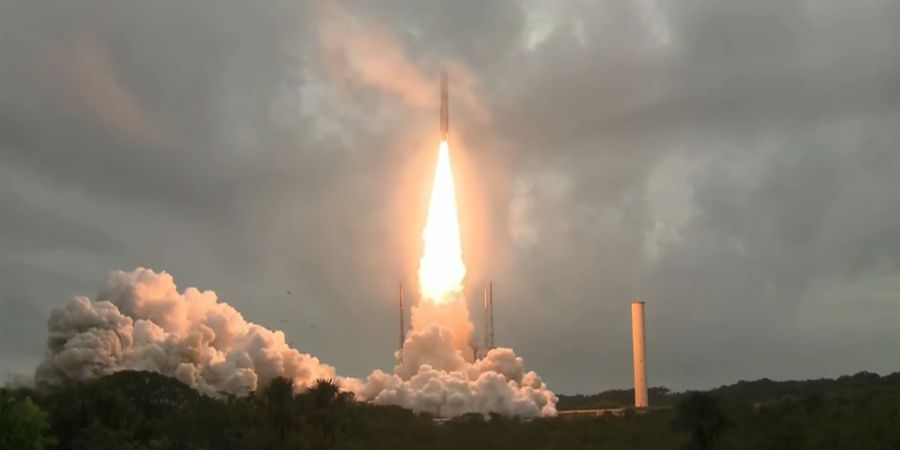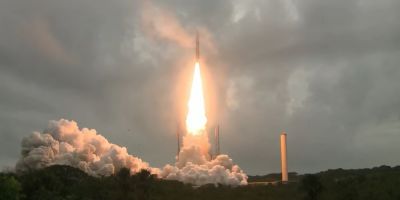 Launch of the James Webb Space Telescope.
Launch of the James Webb Space Telescope.
Photo: European Space Agency/NASA
After years of development and testing, the most advanced James Webb Space Telescope was successfully launched on December 25, 2021. The 6.2-ton space telescope was launched with a powerful European Ariane 5 rocket from the European launch site in French Guiana. The telescope, built by NASA, ESA, and CSA, is the largest space telescope ever launched into space. Using the James Webb Space Telescope, astronomers want to unlock the deepest secrets of our universe.
years of development
The development and construction of the James Webb Space Telescope did not go exactly according to plan and went smoothly. For example, this space telescope was supposed to be launched in 2007, but problems with the development of scientific instruments and the testing of numerous parts always caused delays. In the end, it had long been assumed that the space telescope could be launched in June 2019, but this launch window also did not materialize because the integration of the different parts took longer. In 2020, NASA’s James Webb Space Telescope program manager also reported problems with screws and washers that came loose during testing. This and additional delays due to the Coronavirus (COVID-19) has led to another delay, which means that the launch is now set for October 2021. All this delay has also caused the price of the James Webb Space Telescope to rise again and again, causing the project to be increasingly discussed . While this space telescope was originally thought to cost about half a billion dollars, it actually costs $8.8 billion. And that’s just for the development of the space telescope. When we take into account the cost of launching and operating the space telescope, the total cost of this project is estimated to be $9.8 billion. The 9.8 James Webb Space Telescope finally arrived by ship at the European launch site in French Guiana, South America, on October 12, 2021. The space telescope was immediately transported to the research room where the spacecraft underwent final tests and checks. Finally, on November 25, 2021, the space telescope’s fuel tanks began filling up. This took about ten days. NASA and the European launch company Arianespace announced on December 14, 2021 that a communication problem appeared between the observatory and the launch vehicle system that delayed the planned launch by several days. Finally, a European Ariane 5 rocket launched the space telescope into space on December 25, 2021.
The most advanced space telescope ever
The James Webb Space Telescope is an infrared optical telescope with a 6.5-meter main mirror through which astronomers want to collect light from stars and galaxies that formed shortly after the Big Bang. This ambitious space telescope was designed and built by NASA with significant contributions from Europe (ESA) and Canada (CSA). Although the James Webb Space Telescope is referred to as the successor to the Hubble Space Telescope, it is not at all similar to it. For example, the James Webb Space Telescope looks very different because this telescope has an open design, while the design of the Hubble Space Telescope is comparable to that of the classic telescope. The primary mirror of the James Webb Space Telescope is 6.5 meters in diameter and consists of 18 elements of beryllium coated with a gold layer. Beryllium is strong, light, and can withstand the impacts of micro-meteorites. The gold layer then works to obtain the maximum reflection of infrared rays. Since the main mirror with a diameter of 6.5 meters is too large to launch in one piece, it was decided to fold it during launch and make it unfold in space in time. While the Hubble Space Telescope is designed to look at wavelengths in the ultraviolet, visible, and near-infrared portions of the spectrum, the James Webb Space Telescope will make observations in the infrared portion of the electromagnetic spectrum. Infrared astronomy is very important to astronomers, because cold celestial bodies such as brown dwarfs or protostars located in the depths of a molecular cloud radiate most of the energy in the infrared. Since our star, the Sun, also emits infrared rays, the James Webb Space Telescope will always be turned away from the Sun as well as Earth. With the James Webb Space Telescope, astronomers hope to eventually be able to collect light from stars and galaxies that formed shortly after the Big Bang. In addition, the goal of this new space telescope is to monitor the formation of new galaxies and measure the physical and chemical composition of distant galaxies. Furthermore, this new space telescope should enhance the search for extraterrestrial life by searching exoplanet shells for traces of life.
It operates 1.5 million km from Earth
Unlike the Hubble Space Telescope, the James Webb Space Telescope does not enter a low Earth orbit at an altitude of about 540 km. The James Webb Space Telescope will be located near Lagrangian Point II (L2). At the Lagrangian point, an object as small as a space telescope can maintain a constant relative position with respect to two celestial bodies orbiting around a common center of gravity. Lagrange point L2 is located on the axis between the Earth and the Sun, but is now farther from the Sun than the Earth. This location in space has the advantages that a space telescope is not affected by turbulence from Earth’s atmosphere and that it is cold in this location, which is essential if you want to do infrared astronomy. The second Lagrange point is often used for space observation because the object at L2 maintains the same position relative to the Sun and Earth, which makes calibration easier. There is always a space telescope pointed at this point behind the Sun, Earth and Moon, so protection is easier, and observations can continue around the clock. Lagrange Point 2 is located at a distance of 1.5 million km from Earth. Unfortunately, a position in space such as Lagrange Point 2 also has some major drawbacks. That way you won’t get there as quickly in LEO, and if something goes wrong with the space telescope, the chance of repair is very small. To reach this location, a European Ariane 5 rocket launched from French Guiana the James Webb Space Telescope, after which several crucial course corrections must be made. During the trip to the second Lagrange point, various parts of this space telescope must be exposed, and in no case should the sensitive instruments on the new space telescope be directed towards the Sun. It is estimated that the space telescope will be ready for the first observations six months after its launch.

“Total coffee specialist. Hardcore reader. Incurable music scholar. Web guru. Freelance troublemaker. Problem solver. Travel trailblazer.”







More Stories
GALA lacks a chapter on e-health
Weird beer can taste really good.
Planets contain much more water than previously thought